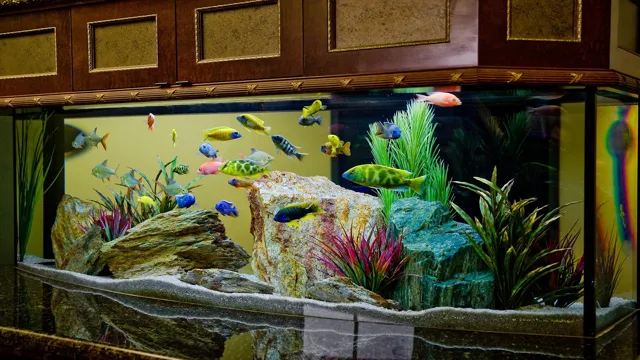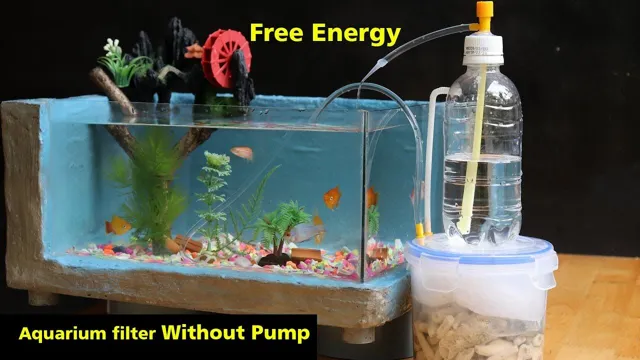Are you excited about setting up your very own aquarium, but not quite sure where to start? Before you can bring your fish home, there are some important steps you need to take to prepare your tank for their arrival. Getting your aquarium ready for fish is crucial for their health and wellbeing, as well as ensuring your tank remains clear and clean. Think of preparing your aquarium for fish like setting the stage for a play.
The better you set up the props and scenery, the smoother the performance will go. First things first, you need to choose the right size tank for your fish and ensure it’s appropriately equipped with a filter, heater, and lighting. Next, you’ll need to cycle your tank to establish a healthy habitat for your fish to thrive in.
It’s crucial to pay close attention to water quality in your aquarium, as fish are highly sensitive to changes in water conditions. This means monitoring chemical levels, pH balance, and keeping up with regular water changes. But don’t worry, we’ll walk you through each step so that your fish can have the best possible start in their new home.
So let’s dive in and get your aquarium ready for fish!
Choosing the Right Size and Type of Aquarium
When getting an aquarium ready for fish, the first thing to consider is the size of the tank. A common mistake is to choose an aquarium that is too small for the type and number of fish. Aquariums come in various sizes, and it is essential to select the right size based on the fish’s needs.
A larger tank allows for more swimming space and better water quality, making it easier to maintain a healthy environment. Secondly, the type of fish you choose will determine the type of aquarium you need. Different fish species have varying requirements, such as water temperature, lighting, and filtering systems.
It is crucial to research beforehand to avoid any problems and ensure that the setup is suitable for the fish you plan to keep. In summary, the right size and type of aquarium play a significant role in keeping your fish happy and healthy in their new home. So, take your time, and do some research before diving in!
Consider the Fish you Intend to Keep
When it comes to choosing the right size and type of aquarium, it’s essential to consider the fish you intend to keep. Different fish species have different requirements, and you need to ensure that the aquarium you choose provides the ideal environment for your aquatic pets. For instance, some fish need a lot of space to swim, while others do well in smaller tanks.
Additionally, consider the adult size of the fish you are planning to keep as many will outgrow their tank if it’s too small, causing stress and health problems. Also, some fish require specific water conditions, such as temperature and pH levels, which must be monitored closely to ensure they remain healthy and happy. By understanding the needs of your fish, you can choose the right size and type of aquarium for them, providing a comfortable and healthy home.

Check the Size and Space Requirements of your Fish
When it comes to choosing an aquarium for your fish, it’s important to consider their size and space requirements. Different types of fish require different tank sizes and settings. For example, a Betta fish can thrive in a 5-gallon tank, while a goldfish requires a minimum of 20-gallon tank.
It’s crucial to research the specific needs of your fish to ensure they have enough space to swim and grow, as well as proper filtration to keep the water clean. Not only will this result in a happier and healthier fish, but it will also make maintenance easier for you in the long run. Remember, it’s important not to overcrowd your aquarium, as this can lead to stress, disease, and even death for your fish.
Always start with the appropriate tank size and aim for one inch of fish per gallon of water. Investing in the right size and type of aquarium can make all the difference in the well-being of your fish.
Select the Tank Size that Accommodates your Fish
When it comes to setting up an aquarium, selecting the right size and type is essential to ensure the health and happiness of your fish. Choosing a tank that accommodates your fish is crucial for their growth and well-being. Bettas, for example, are known for their need to swim to the surface for air, making a long and shallow tank ideal for them.
On the other hand, larger fish like angelfish require a taller tank to provide them with adequate vertical swimming space. It is important to consider the number and size of your fish when selecting a tank to avoid overcrowding and stress. Additionally, the type of aquarium also plays a significant role in your fish’s well-being. (See Also: How to Maintain Duckweed in an Aquarium: Tips and Tricks for Healthy Growth)
A freshwater tank requires different equipment and maintenance than a saltwater tank, so it is essential to research and select the appropriate type before purchasing anything. Overall, it is important to do your research and choose a tank that will provide your fish with the space and environment they need to thrive. After all, a healthy and happy fish makes for a happy owner.
Finding the Right Spot for Your Aquarium
If you’re getting ready to set up an aquarium for fish, one of the most important factors to consider is the right spot for your tank. Picking the location for your aquarium requires some planning, and there are a few key things you need to keep in mind. First and foremost, you’ll want to choose a location that is stable and secure, so that your tank doesn’t get bumped or knocked over.
Next, consider the lighting in the room where you’ll place your tank – you want to avoid direct sunlight that can promote algae growth and also avoid a room that is too dark without natural light. Finally, you’ll want to make sure you have access to a power outlet and a nearby water source for cleaning and maintenance. With these factors in mind, you’ll find the perfect spot to showcase your beautiful fish tank.
Select a Stable and Level Surface
When getting ready to set up your aquarium, one of the first things you need to consider is where to place it. It’s important to find a stable and level surface for your aquarium, as it will be quite heavy once filled with water. Avoid placing it on uneven furniture or floors, as this can cause stress points on the glass and potentially lead to cracks or leaks.
If you don’t have a suitable table or stand, consider purchasing one designed specifically for aquariums. Another thing to keep in mind is the amount of light the area gets. Too much direct sunlight can promote algae growth, so it’s best to choose a spot that isn’t in direct sunlight for more than a few hours a day.
By taking the time to find the right spot for your aquarium, you can ensure that your fish will thrive in their new home.
Avoid Direct Sunlight and Drafts
When it comes to setting up an aquarium, finding the right spot in your home is crucial for the health and well-being of your fish. One important factor to consider is avoiding direct sunlight and drafts. Direct sunlight can lead to algae growth and fluctuations in temperature, which can be harmful to your fish.
On the other hand, drafts can lower the temperature and cause stress to your fish, while also disrupting the natural flow of the water. It’s best to choose a spot that is away from windows and high-traffic areas, where the temperature and lighting can be controlled. Remember, a happy and healthy environment for your fish is essential for their longevity and overall happiness.
So, take the time to choose the right location and ensure the conditions are just right for your aquatic friends to thrive.
Ensure an Accessible Outlet for Power and Water Change
When it comes to setting up an aquarium, one of the most critical steps is finding the right spot for it in your home. Not all areas are created equal, and different environments can have a significant impact on the well-being of your aquatic pets. One of the primary considerations you’ll need to factor in is the accessibility of power and water sources.
You’ll want to ensure that you have an easily accessible outlet for your aquarium equipment and that the nearest water source is close enough for easy water changes. Ideally, you’ll want a spot that offers both proximity to these essential utilities and is convenient to maintain. Keep in mind that you’ll need enough space for your tank, equipment, and other accessories, so choose a location that will accommodate your setup without feeling cramped.
With the right location and careful planning, you’ll set your aquarium up for success and provide a beautiful and healthy environment for your aquatic friends to thrive.
Setting up Your Aquarium
Setting up your aquarium can be both exciting and overwhelming. To get your aquarium ready for fish, there are a few important steps to take. First, make sure you have the right size tank for the type and number of fish you plan to keep. (See Also: How to Clear Your Aquarium After Adding Crushed Coral: Simple and Effective Tips)
Next, clean the tank thoroughly using a mild, aquarium-safe cleaner and rinse it well. Add a layer of substrate (such as sand or gravel) to the bottom of the tank and arrange any decorations or plants. Fill the tank with water that has been treated to remove chlorine and other harmful chemicals.
Finally, allow the filter and heater to run for a few days before adding any fish, to ensure that the water parameters are stable and safe for them. By following these steps, you can create a healthy and thriving environment for your new aquatic friends. Remember, a well-prepared aquarium is key to keeping your fish happy and healthy for years to come!
Add a Substrate to the Bottom of Your Tank
If you’re setting up your aquarium, one crucial step is to add a substrate to the bottom of your tank. A substrate refers to the material used to cover the bottom of your aquarium, and choosing the right one is essential for the health of your aquatic life. Different substrates will provide different benefits, so it’s important to choose one that suits your needs.
Sand, for example, is an excellent substrate for fish that burrow or sift through the sand for food. Gravel, on the other hand, provides excellent water flow, which is crucial for filters and aquatic plants. Make sure to also consider the size of your substrate, as larger particulates can trap debris and may require more maintenance.
By choosing the right substrate, you’ll be creating a healthy environment for your aquatic pets to thrive. So, make sure to research and choose the best substrate for your aquarium.
Install a High-Quality Filtration System
An essential component to any successful aquarium is a high-quality filtration system. Not only does it help maintain the cleanliness of the tank, but it also provides a healthy environment for the fish to thrive in. When setting up your aquarium, it’s important to consider the type and size of the filtration system that is needed for the specific needs of your fish.
A basic power filter may suffice for smaller freshwater tanks with only a few fish, but larger or more complex systems may require a canister filter or protein skimmer to effectively remove waste and maintain water quality. It’s also important to regularly clean and maintain the filtration system to ensure peak performance and avoid any potential issues that may arise. By investing in a high-quality filtration system, you can provide a safe and healthy living space for your aquatic pets.
Add Plants to Create an Environment for Your Fish
When it comes to setting up your aquarium, adding plants can create an environment that is beneficial for your fish. Not only do plants add aesthetic value to your tank, but they have several benefits for the fish. They provide oxygenation and filtration, which helps maintain good water quality.
Moreover, fish can use plants as hiding places, reducing stress levels and promoting a healthy fish habitat. If you are a beginner, it is best to choose easy-to-care-for plants such as Java fern, Amazon Sword, or Anubias. These plants require low light and are relatively easy to maintain.
However, it is essential to note that too many plants can cause problems if they overgrow; ensure you keep them under control by pruning them regularly. In summary, adding plants to your aquarium can greatly enhance your fish’s habitat, providing several benefits that promote a healthy and vibrant underwater ecosystem.
Check Water and Temperature Parameters
Setting up your aquarium can be an exciting process, but it’s important to make sure that you have the right water and temperature parameters established before introducing any fish. Start by testing your tap water for pH, ammonia, nitrates, and nitrites using an aquarium test kit. If any of these levels are off, you can use water conditioners or treatments to adjust them.
Once you have your water parameters in check, it’s time to focus on temperature. Different fish species have different temperature requirements, so it’s important to research the needs of your specific fish. Invest in a high-quality aquarium heater and thermometer to ensure that your aquarium stays at a consistent and comfortable temperature for your fish.
By taking the time to properly set up your aquarium, you can create a thriving and healthy environment for your aquatic friends to call home. (See Also: How to Get Rid of Aquarium Worms: Effective Ways to Eliminate Pesky Worms from Your Fish Tank)
Conclusion
In conclusion, preparing an aquarium for fish is a bit like hosting a dinner party. You want to make sure the atmosphere is just right – clear water, optimal pH levels, and appropriate temperature. You also want to make sure your guests feel comfortable – providing shelter and hiding places like decorations and plants for them.
And just like any good party host, you’ve got to stay on top of things – monitoring water quality regularly and performing necessary maintenance. So, whether you’re a seasoned fish enthusiast or a newbie, with the right preparation and care, you can create a beautiful and healthy home for your finned friends. Just remember, unlike a dinner party, the fish don’t bring dessert – that’s on you.
Happy fish-keeping!”
FAQs
Why is it important to cycle an aquarium before adding fish?
Cycling an aquarium involves establishing beneficial bacteria that will help break down fish waste and keep the water healthy for the fish. Without proper cycling, the water quality can quickly decline and harm the fish.
How long does it take to cycle an aquarium?
The length of time it takes to cycle an aquarium can vary, but it typically takes anywhere from 4-6 weeks. This process can be sped up by adding beneficial bacteria supplements or using live plants.
What equipment do I need to set up an aquarium?
Some essential equipment needed to set up an aquarium include a tank, a filter, a heater, a thermometer, substrate, and decorations. Additional equipment like a water testing kit and air pump may also be beneficial.
How many fish can I add to my aquarium at once?
It is recommended to only add a few fish at a time, typically no more than 2-3, depending on the size of the tank and the type of fish. Adding too many fish at once can lead to excess waste and poor water quality.
What type of fish should I add to my aquarium?
It’s important to choose fish that are compatible with each other and with the size of the tank. Research the specific needs and behaviors of different fish species before adding them to your aquarium.
How often should I clean my aquarium?
Regular maintenance is crucial for a healthy aquarium. A general rule of thumb is to do a 10-20% water change every 1-2 weeks and clean the filter every month. However, the cleaning schedule may vary depending on the size of the tank and the number of fish.
What should I do if my fish are sick?
Look for signs of illness, such as changes in behavior or appearance, and quarantine the sick fish if necessary. Consult with a veterinarian or an experienced fish keeper for advice on treatment options. It’s also important to maintain water quality and ensure proper nutrition to prevent illness.







